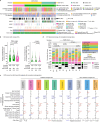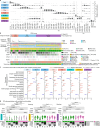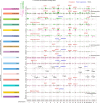This is a preprint.
Panorama of Chromosomal Instability in Lung Cancer
- PMID: 41018008
- PMCID: PMC12466783
- DOI: 10.1101/2025.09.09.25335109
Panorama of Chromosomal Instability in Lung Cancer
Abstract
Lung cancer is a highly heterogeneous disease primarily driven by tobacco smoking. About 20% of lung cancers occur among patients who have never smoked (LCINS) with differences in patient ancestry, sex, tumor histology, and clinical features. Our understanding of chromosomal instability in lung cancer, especially LCINS, is still limited. Here, we perform a comprehensive study of 182,429 somatic structural variations (SVs) detected in 1,209 whole-genome sequenced lung cancers, of which 864 LCINS. SVs are more abundant in tumors from patients who have smoked (LCSS); however, they are more complex and play more important roles in tumorigenesis in LCINS. EGFR mutations and KRAS mutations profoundly and independently shape the SV landscape. EGFR-mutant tumors have higher SV burden and more cancer-driving SVs. In contrast, KRAS mutations are associated with lower SV burden and less driver SVs. We decompose 16 SV signatures for both complex and simple SVs that likely represent divergent molecular mechanisms. The SV breakpoints have distinct distributions across the genome depending on the signatures due to mutagenic mechanisms and positive selection. Many established cancer-driving genes are recurrently rearranged by multiple SV signatures suggesting functional convergence of these genome instability mechanisms.
Conflict of interest statement
Disclosure L.B.A. and M.D-G. declare a European patent application with application number EP25305077.7. All other authors have no competing interests to declare. L.B.A. is a co-founder, CSO, scientific advisory member, and consultant for io9, has equity and receives income. The terms of this arrangement have been reviewed and approved by the University of California, San Diego in accordance with its conflict of interest policies. L.B.A. is also a compensated member of the scientific advisory board of Inocras. L.B.A.’s spouse is an employee of Biotheranostics. E.N.B. and L.B.A. declare U.S. provisional patent application filed with UCSD with serial numbers 63/269,033. LBA also declares U.S. provisional applications filed with UCSD with serial numbers: 63/366,392; 63/289,601; 63/483,237; 63/412,835; and 63/492,348. L.B.A. is also an inventor of a US Patent 10,776,718 for source identification by non-negative matrix factorization. L.B.A. and M.D-G. further declare a European patent application with application number EP25305077.7. S.R.Y. has received consulting fees from AstraZeneca, Sanofi, Amgen, AbbVie, and Sanofi; received speaking fees from AstraZeneca, Medscape, PRIME Education, and Medical Learning Institute. All other authors declare that they have no competing interests.
Figures






References
Publication types
Grants and funding
LinkOut - more resources
Full Text Sources
Research Materials
Miscellaneous
